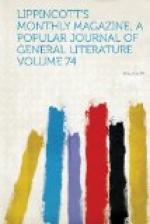A still more diffused, perhaps, if less productive, source of life exists in another burrower and mound-builder, the crawfish. Unlike the ant, which likes to drain, he is an advocate of irrigation. In this art he can give our well-diggers odds in the game. His genius for striking water is wonderful. On the dryest parts of the prairie, miles from any permanent stream, his ejections of mud may be found. Shallow or deep, his borings always reach water. He is always at home, but less accessible to callers than the ant. To the smaller birds he is forbidden fruit. In wet weather, when his vestibule is shallow, the sand-hill crane may burglarize him, or even get a snap judgment on him at the front door. The bill of the great curlew cannot be sent in so effectively, not being so rightly drawn; but that bird, more common in the season than anywhere else away from the coast, finds plenty of other food. He is not here in the winter. His place just now is filled by the jacksnipe, which flutters up from every boggy place and comes to bag in a condition anything but suggestive of short commons. The snipe’s terrestrial surface lies two and a half inches beneath ours. At that distance he strikes hard pan; but it is margin enough for his operations, and he is not often caught among the shorts. Gourmands assure us that he lives “by suction,” and that there is consequently no harm in eating his trail. There is comfort in this creed, whatever may be our private belief in the substantiality of what the bird absorbs; and we cheerfully eat, after the suggestion of Paul, “asking no questions,” the while tacitly assuring ourselves, like old Fuller with the strawberry, that a better bird might doubtless have been made, but as certainly never was. For game flavor not even the partridge (Bob White), also exceptionally abundant here, is his superior.




